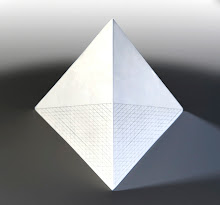Pro-acting as a free agent, the Individual operates free-erratically, errantly, and independently, yet exists in a collaborative framework, whether intentionally or unintentionally. Validated by Postmodernism’s assertion of the pluralistic hyperindividuated self as All-Important, the Individual indulges caprice, whim, narcissism, wanton hendonism, to its own sugar-fueled Implosion. Moving rapidly beyond Post- to Trans-, I assert myself as an Individual operating to great advantage within overlapping, navigable, operable, malleable, and propagative structural frameworks constructed of the fragments of Epic Oneness Modernism and HyperMe Postmodernism, enabled by simultaneous emergence of collective effort, desire, and will, elucidated by the emergent phenomena of Open Source.
Opposed to all prior social models, Open Source culture allows one to cull from a collective consciousness as frequently and nearly as fast as one can reference their own experience (perhaps faster), and infinitely more expeditiously than one might possibly experience the collective’s myriad experiences personally. Referencing the benefits of open source culture more broadly, I and multiplicitous others operate as an augmented, concurrent We. Moving beyond data sharing, We propose the Open Sourcing of Education, Architecture, Art, Religion, Ontology. Looking like the Situationist’s wildest dreams of free play, Open Source operates as a platform for institutionally extraneous transbelief, which is realized as transnational, transhistorical, and integral pursuit formulated as an overarching, holistic, perpetually adaptive, real-time rendering, self-centering model of the self, in which the self has both free agency and demonstrable frameworks of operable relationships; in which the self is both a foci and a tangential node to infinitely varied co-extant foci. Emerging strategies of combinative digital media allow synthesis of transcendent experience, a networked ecstasy, a state both momentarily psychedelic and trans-spiritual. Aware of the possibilities of multi-level, multilateral collaboration for achieving a greater whole, We pursue development and utilization of emergent technologies while simultaneously creating new fusions of existing disciplines for a trans-genre sensorial experience, dissolving boundary demarcations as a means to provide the purest achievable realization of a given idea without paradigmatic restrictions, using the techniques of architecture, art, computer and social programming, religion, and social practice, in order to symbiotically syncretize an experience not possible nor recognized within the specified limits of any of those disciplines, thereby moving beyond cultivating merely either metaphor or utility, into actualizing new experiential phenomena for its own purpose, that of filling a receptive void.
Re-interpreting the utopianism of early digital visualizations into physical space by combining existing physical with emergent digital technologies, the human body is finally beginning to integrate into both the digital network and designed physical space in a way previously portrayed as futurist, idealist, and fantastical. In this iteration, however, a realm of possibility and agency begins to extend real limbs into the physical world, rather than errant humans escaping, displaced, into the digital realm. Combining the “epic oneness” meta-narrative of Modernism with the pluralism of Post-Modernism into a symbiosis sustained by collaboration, We attempt to integrate the utopianism of the former with the individualism of the latter, in order to overcome oppressive and fascistic tendencies by allowing for the idiosyncrasy, will, and desire of the Individual within the collective entity. Beyond being non-denominational to being non-religious, beyond being merely formally spiritual to an emergent state of immediate transconsciousness, We interrogate our relationship to the Ideal. By utilizing ideal and idealized forms, e.g. sacred geometry, utopianism, futurism, symmetry, We investigate the demonstrable prevalence of universals, inherent problematics and discrepancies within those Ideals, and contortionist philosophical matrices a la Le Corbusier. Moving forward, We intend to, and do, distort rational systems via human presence, exerting forces via idiosyncracies which tessellate imposed matrices advantageously for the individual contained therein.
Specifically, We intentionally mediate our investigation through purposes and techniques of art, combined with utilitarian aims and phenomenological strategies of architecture and collaborative possibilities of social practice, augmented by interactive media, as a means of simultaneously promoting philosophical/conceptual/ontological contemplation of the social, ideological, and technological aspects of the work, as well as intending to all possible degrees to blur the boundaries of Art --expanding, contorting, and blending the Paradigm with others in a way heretofore unseen and impossible. We use appropriate paradigms when they are useful; when presented with an opportunity in a given realm, the work is re-configured to most succinctly agitate the parameters of that paradigm. At a given moment, the output of our research may manifest itself as art qua Art, pedagogy as beta testing for collaborative/socially interactive experiments, urban sphere performance spectacle, theoretical writing, interactive multi-media programming, online community cultivation, open collaborative events in real time and space, esoteric subculture injections, all specifically and intentionally aestheticized. We utilize stylisms, formalisms, acute aestheticization as an intriguing and appealing entry route into the work. Subtly and overtly contorting understood formalisms, We create work that is impeccably stylized and surfaced, enabling visual intrigue and a referential mystique (explicitly, in this case, aesthetics of various utopianisms and science fiction, combined with formal tropes of institutionalized religion) that draws the viewer to a place where they are able to experience the work. Simultaneously, the use of the heavy-handedness, exaggerated camp, and hopeless stylisms of said references allow the work to be taken both seriously and parodically, subverting hardline utopian and fundamentalist readings of the work. However, these aestheticizations are easily ejected and replaced when prohibitive or not useful.
More specifically, the current content being subjected to this model may be stated thus: an investigation into the social choreography employed by institutions of belief through organized formal techniques in architecture, graphic design, and data transmission, the intersection and contradictions of said techniques with those employed by science fiction and utopias, how these shift when applied to contemporary techniques and in contemporary venues, and finally, how these techniques shift and enable new social relationships when they are divested of religious or fascistic imperatives.
Wednesday, December 31, 2008
Subscribe to:
Comments (Atom)
